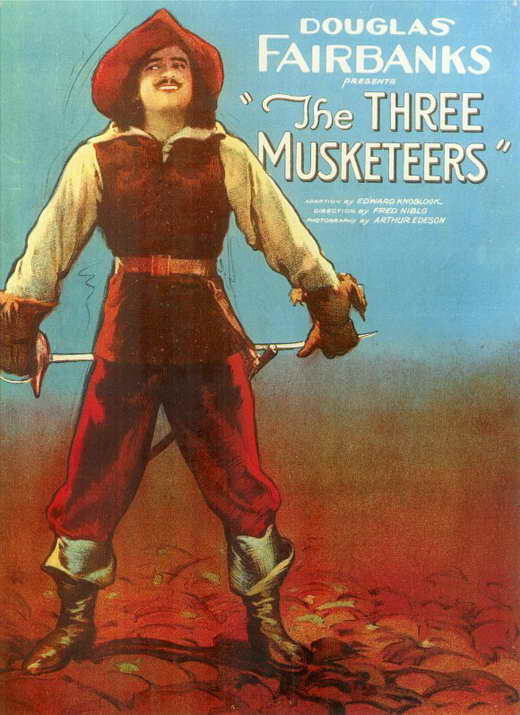Believe it or not, Fred Niblo’s 1921 action-adventure film The Three Musketeers is my first foray into the story of the swashbuckling heroes. Sword fights have never really been something that excite me (which is strange considering I love Star Wars and its essentially swords made out of light). It’s probably why films like Gladiator, Pirates of the Caribbean, Zorro and many others never really stuck with me that long. For me, the most exciting aspects about them are often the political back-dealings, but even then they get tiring as they often involve one evil character trying to gain all the power and one good character fighting to ensure justice is served. Perhaps Dumas’ classic tale is the original, but after watching so many of the same story, it certainly becomes a bore to me.
However, the infamous team of Niblo and Douglas Fairbanks (as the unofficial fourth musketeer, D’Artagnan) work wonders to bring the tale to the big screen. Though it’s not a film I would consider a favorite – again, these stories often don’t entertain me as they do others, which obviously ruins my Willing Suspension of Disbelief (a.k.a. I don’t get to have a good time) – it still managed to keep my attention for the majority of the film. The fight sequences are very much of its time, very little choreography, melodramatic death sequences, and worst of all minimal realism, but for being a fun, action-adventure film for its time, it does just fine within its tonal range.
Considering this is my first film for Fairbanks (shown below) as well, as all I’ve known about him is that he gave the go-ahead to let Buster Keaton star in his role for The Saphead (a role he originated in the play), and I suppose from that I can see how he could play a Keaton-like role on the big stage. However, as an actor – judging solely from this one film – it’s easy to see why he was well-liked and popular at the time (he has tons of charisma, he’s not terrible-looking, and he’s full of humor and heart), but not for one second did I buy him as D’Artagnan. I know, I know, it’s only my first incarnation of the tale and I never read the novel – perhaps he actually nailed him perfectly. But if that’s the case, it gives me very little reason to want to read the book because I felt like his take on the character was so over-the-top and campy that I never bought him to be “the one” who could bring down the Cardinal Richelieu’s premier sword-fighters. Again, breaking that Willing Suspension of Disbelief.
I suppose all of this sounds like I’m bashing the film, but really it’s not that bad. It’s very much of its time, and that’s an unfortunate criticism for many films I’ve reviewed from the 1920s so far, but I try to avoid that in my ratings and overall perception of films. For me – did it entertain or inform? Did it allow me to escape in this world? Was I engaged by the characters and the story? In the case of this film, I suppose these answers would be a yes, but a very slight yes. Niblo’s direction is entertaining, as is the story engaging, but it’s hard to immerse myself in a world when each of the elements aren’t coming together as cohesively as they should. Perhaps if Fairbanks were in a comedic version of the film, he’d be magnificent. Or if the rest of the actors, such as Nigel De Brulier (as Cardinal Richelieu), were in a serious film separate from Fairbanks’ goofy portrayal – perhaps then could the film find a solid, consistent tone.
For what it is, it’s a decent introduction to the popular tale of Alexandre Dumas and an entertaining enough way to pass the time. But perhaps the only reason the film still lives on today is because it’s an adaptation of a popular tale. Then again, I’ve yet to hear anyone say anything good about a Three Musketeers film thus far, so perhaps they just haven’t gotten it right yet. Maybe Fairbanks will impress me in a film that doesn’t benefit from a more serious tone.

_2.jpg)

_-_3.jpg)
No comments:
Post a Comment